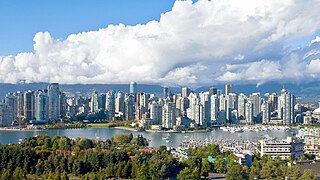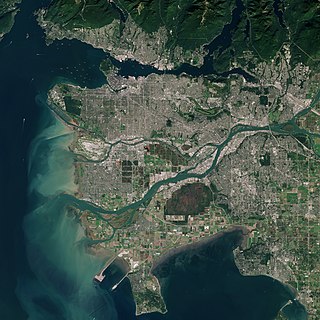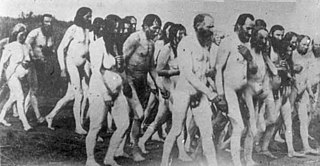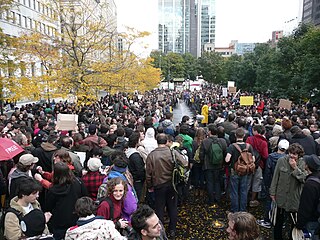Related Research Articles

Vancouver is a major city in western Canada, located in the Lower Mainland region of British Columbia. As the most populous city in the province, the 2021 Canadian census recorded 662,248 people in the city, up from 631,486 in 2016. The Greater Vancouver area had a population of 2.6 million in 2021, making it the third-largest metropolitan area in Canada. Greater Vancouver, along with the Fraser Valley, comprises the Lower Mainland with a regional population of over 3 million. Vancouver has the highest population density in Canada, with over 5,700 people per square kilometre, and fourth highest in North America.

The Metro Vancouver Regional District (MVRD), or simply Metro Vancouver, is a Canadian political subdivision and corporate entity representing the metropolitan area of Greater Vancouver, designated by provincial legislation as one of the 28 regional districts in British Columbia. The organization was known as the Regional District of Fraser–Burrard for nearly one year upon incorporating in 1967, and as the Greater Vancouver Regional District (GVRD) from 1968 to 2017.
A nonviolent revolution is a revolution conducted primarily by unarmed civilians using tactics of civil resistance, including various forms of nonviolent protest, to bring about the departure of governments seen as entrenched and authoritarian without the use or threat of violence. While many campaigns of civil resistance are intended for much more limited goals than revolution, generally a nonviolent revolution is characterized by simultaneous advocacy of democracy, human rights, and national independence in the country concerned.

Nudity is sometimes used as a tactic during a protest to attract media and public attention to a cause, and sometimes promotion of public nudity is itself the objective of a nude protest. The use of the tactic goes back to well published photos of nude protests by svobodniki in Canada in 1903. The tactic has been used by other groups later in the century, especially after the 1960s. Like public nudity in general, the cultural and legal acceptance of nudity as a tactic in protest also varies around the world. Some opponents of any public nudity claim that it is indecent, especially when it can be viewed by children; while others argue that it is a legitimate form of expression covered by the right to free speech.

Occupy Wall Street (OWS) was a 59-day left-wing populist movement against economic inequality and the influence of money in politics that had begun in Zuccotti Park, located in New York City's Wall Street financial district, and lasted from September 17–November 15, 2011. The protests gave rise to the wider Occupy movement in the United States and other Western countries.

The Occupy movement was an international populist socio-political movement that expressed opposition to social and economic inequality and to the perceived lack of "real democracy" around the world. It aimed primarily to advance social and economic justice and different forms of democracy. The movement has had many different scopes, since local groups often had different focuses, but its prime concerns included how large corporations control the world in a way that disproportionately benefits a minority, undermines democracy and causes instability.

Occupy Canada was a collective of peaceful protests and demonstrations that were part of the larger Occupy Together movement which first manifested in the financial district of New York City with Occupy Wall Street, and subsequently spread to over 900 cities around the world.

The 15 October 2011 global protests were part of a series of protests inspired by the Arab Spring, the Icelandic protests, the Portuguese "Geração à Rasca", the Spanish "Indignants", the Greek protests, and the Occupy movement. The protests were launched under the slogan "United for #GlobalChange", to which the slogan "United for Global Democracy" was added by many people's assemblies. The protest was first called for by the Spanish Plataforma ¡Democracia Real YA! in May 2011 and endorsed by people's assemblies across the world. Reasons were varied but mainly targeted growing economic inequality, corporate influence over government and international institutions, and the lack of truly democratic institutions allowing direct public participation at all levels, local to global. Global demonstrations were held on 15 October in more than 950 cities in 82 countries. The date was chosen to coincide with the 5-month anniversary of the first protest in Spain. General assemblies, the social network n-1, mailing lists, Mumble voice chat, open pads such as Pirate Pad and Titan Pad, and Facebook were used to coordinate the events. Some protests were only a few hundred in number, whereas others numbered in the hundreds of thousands, with the largest in Madrid numbering half a million and the second largest city Barcelona with 400,000.

Occupy Philadelphia was a collaboration that included nonviolent protests and demonstrations with an aim to overcome economic inequality, corporate greed and the influence of corporations and lobbyists on government. The protest took place at Thomas Paine Plaza, which is adjacent to Philadelphia's City Hall.

Occupy Eugene was a collaboration that occurred in Eugene, Oregon based on the Occupy Wall Street movement which began in New York City on September 17, 2011. Occupy Eugene included peaceful protests and demonstrations. Protesters were concerned about inequities in the distribution of wealth, banking regulation, housing issues and corporate greed. The first protest march was held on October 15, 2011. The march started at the Wayne Morse Free Speech Plaza and continued downtown before marching over Ferry Street Bridge. It was reported that close to 2000 people were in attendance from all over the state of Oregon. Occupy Eugene continued to hold regular protests and actions until it left the encampment in December 2011. Protesters have stated that they do not have a set group of leaders. Occupy Eugene General Assemblies have met from as frequently as twice a day at times during active occupations, and as infrequently as weekly. Many committees have met since at least the third General Assembly, typically weekly. Decisions are made through a process known as consensus. Occupy Eugene's consensus process operates in a similar fashion to how consensus is being handled in New York City by protesters involved in Occupy Wall Street. Although the exact method varies from Occupation to Occupation. As of October 18, 2011, The Eugene police department was allowing protesters to camp in downtown Eugene, although city law prohibits it. Eugene police also stated that downtown camping won't be permanently allowed.
Occupy Windsor was an Occupy movement encampment in David Croll Park, Windsor, Ontario, Canada. The protest ended and all protesters evacuated the area on December 12, 2011 with promises to return to the park to reseed areas damaged by the camp.

Since September 2011, the Occupy movement has spread to over 80 countries and 2,700 towns and cities, including in over 90 cities in the United States alone. The movement has generated reactions from the media, the general public, the United States government, and from international governments.

Occupy Ottawa was a mostly peaceful, leaderless, grassroots and democratic protest movement that began on Confederation Park in Ottawa, Ontario, on October 15, 2011. The movement's slogan "Home of the global revolution in Ottawa" refers to its inspiration by, and association with, the Arab Spring, Occupy Wall Street and the global Occupy Movement, which protests growing economic inequality, corporate greed, and the influence of corporations and lobbyists on electoral politics and government. Occupy Ottawa seeks global economic, social, political and environmental justice.
The Occupy Wall Street demonstrations garnered reactions of both praise and criticism from organizations and public figures in many parts of the world. Over time, a long list of notable people from a range of backgrounds began and continue to lend their support or make reference to the Occupy movement in general.
Occupy Vanderbilt was a collaboration that included demonstrations and an occupation located at Alumni Circle Lawn at Vanderbilt University in Nashville, Tennessee. Occupy Vanderbilt engaged in organized meetings, events and actions through March 2012. The occupation was in solidarity with the global occupy movement and Occupy Nashville, and is notable as the first protest encampment at Vanderbilt, the spread of which in countries like Argentina, Greece and Spain originally inspired the Occupy movement.

Plaza Moriones is a major public square in Tondo, Manila. Unlike other squares in Manila, the plaza is in the shape of a linear park occupying the central median of Moriones Street, starting at the intersection of Moriones and Juan Luna Streets, and ending at the intersection with Santa Maria Street, bisected by Nicolas Zamora Street in the center. It is named after Governor-General Domingo Moriones y Muralla, responsible for the construction of Manila's sewerage system during his tenure from 1877 to 1881.

Occupy Love is a 2012 documentary film about the Occupy movement directed by Velcrow Ripper. The film premiered at the 2012 Vancouver International Film Festival.
References
- ↑ Reyes, Min. "Min Reyes: Stephen Harper government is in contempt of Canadians". Georgia Straight . February 6, 2012. Retrieved 8 October 2012.
- ↑ TORREVILLAS, PHYLICIA (13 October 2012). "Occupy movement a global awakening, Canadian author tells group". Metro Vancouver. Metro International . Retrieved 8 October 2012.
- ↑ Antonia Zerbisias (June 23, 2012). "Meet Min Reyes, Canada's top political tweeter". Toronto Star . Retrieved 8 October 2012.
- ↑ Ben Nelms (photographer) (14 October 2011). "Faces of Canada's Occupy protests". The Globe and Mail . Retrieved 8 October 2012.